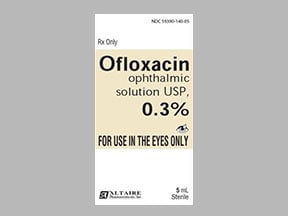
Ofloxacin Coupons & Savings Card – Discount Prices from $14.30
Generic for: Ocuflox
My prescription
Edit
10ML of 0.3%, Ofloxacin (1 Bottle)
Select pharmacy

CVS
$22.86
COUPON PRICE
Walmart
$14.30
COUPON PRICE
Walgreens
$19.97
COUPON PRICE
Albertsons
$25.77
COUPON PRICEOfloxacin savings card
Show this card to your pharmacist
Walmart
$14.30
BIN
ID
PCN
GRP
015995
LHEV736861
GDC
GDRX
Powered by
More prescriptions for urinary tract infection
More prescriptions for urinary tract infection
Ofloxacin dosage forms
Dosage Quantity Price from Per unit 10ML of 0.3% 1 Bottle $22.86 $22.86 10ML of 0.3% 2 Bottles $27.72 $13.86 10ML of 0.3% 3 Bottles $32.58 $10.86
| Dosage | Quantity | Price from | Per unit |
|---|---|---|---|
| 10ML of 0.3% | 1 Bottle | $22.86 | $22.86 |
| 10ML of 0.3% | 2 Bottles | $27.72 | $13.86 |
| 10ML of 0.3% | 3 Bottles | $32.58 | $10.86 |
Ofloxacin Warnings
This safety information provides essential warnings and precautions for using ofloxacin, a quinolone antibiotic. It is crucial to understand these risks to ensure your health and safety during treatment. Please consult your healthcare provider if you have any concerns.
Tendon Damage: Ofloxacin can cause serious tendon issues, including tendonitis and tendon rupture, particularly in the Achilles tendon. This risk can persist even after treatment ends. If you experience joint or muscle pain or swelling, stop taking ofloxacin and seek medical advice immediately. Those over 60, taking corticosteroids, or with a history of transplants or tendon-related conditions are at increased risk.
Neurological and Mental Health Effects: This medication may lead to nerve damage, seizures, dizziness, tremors, and changes in mood or mental state. Symptoms can include pain, numbness, tingling, and mood changes, including depression or suicidal thoughts. Those with a history of seizures or nerve issues should be especially cautious. Immediate medical help is necessary if these symptoms occur.
Myasthenia Gravis Worsening: Ofloxacin can exacerbate symptoms of myasthenia gravis, such as muscle weakness and breathing difficulties. Discuss alternative antibiotics with your doctor if you have this condition.
Severe Allergic Reactions: Rare but severe allergic reactions can occur, including anaphylaxis, characterized by symptoms like hives, rash, facial swelling, and difficulty breathing. Immediate medical attention is required if these occur.
Liver Damage: Though rare, serious liver problems have been reported. Symptoms such as stomach pain, yellowing of the skin or eyes, and dark urine necessitate stopping the medication and contacting a healthcare provider.
Infectious Diarrhea: Ofloxacin can increase the risk of C. difficile infection, leading to severe diarrhea with symptoms like rapid heart rate and frequent bowel movements. Immediate medical attention is required for these symptoms.
Sun Sensitivity: Increased sensitivity to sunlight or UV light is possible, leading to sunburns. Use sunscreen and protective clothing when outdoors, even in winter or on cloudy days.
Aortic Damage: There is an elevated risk of severe aortic damage, especially in older adults. Symptoms like sudden severe pain in the chest, back, or stomach require emergency medical attention.
QT Prolongation: This condition affects heart rhythm and can be life-threatening. Those with a history of heart problems or taking medications that affect heart rhythm should be cautious. Symptoms like chest pain or faintness require immediate medical help.
Contraindications: Do not use ofloxacin if you have a severe allergy to fluoroquinolone antibiotics.
Always discuss with your healthcare provider to fully understand the implications of these warnings and to consider alternative treatments if necessary.
Ofloxacin Side Effects
Common side effects:
- nausea
- trouble sleeping
- headache
- dizziness
- diarrhea
- vomiting
- itching
- changes in taste
Serious side effects:
- seizures
- thoughts of self-harm
- unusual pain and swelling around joints or muscles, such as Achilles pain
- nerve damage (numbness, tingling, or burning sensations)
- major blood vessel damage (sudden severe pain in chest, back, or stomach, and shortness of breath)
- C. difficile-related diarrhea (foul-smelling stools, frequent bowel movements, and fever)
- abnormal heart rhythms (chest pain, fainting, or shortness of breath)
- liver issues (stomach bloating, yellowing of the skin or eyes, and dark urine)
- severe allergic reactions (hives, blisters, skin peeling, and difficulty breathing)
Ofloxacin Interactions
Interactions with high risk of serious adverse effects and should be avoided:
- Bepridil
- Cisapride
- Dronedarone
- Mesoridazine
- Pimozide
- Piperaquine
- Saquinavir
- Sparfloxacin
- Terfenadine
- Thioridazine
- Ziprasidone
- Levofloxacin
Interactions with moderate risk that may require dose adjustment, closer monitoring, or timing changes:
- Acarbose
- Acecainide
- Amiodarone
- Ciprofloxacin
- Acarbose
- Acecainide
- Amiodarone
- Ciprofloxacin
- Dofetilide
- Procainamide
- Quinidine
- Sotalol
Interactions with low risk that usually do not require a change in therapy:
- Aminolevulinic Acid
- Didanosine
- Lanthanum Carbonate
